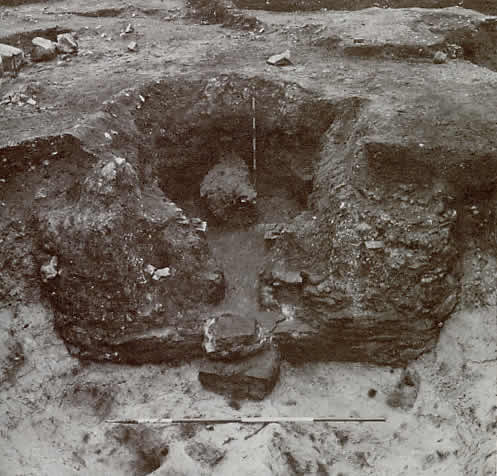Pakenham History : Pakenham-Village of Two Mills - NR Whitwell
A book written by N.R. Whitwell
with permission kindly given by S. Whitwell to publish on
the Pakenham -Village web site.
| Front Cover | Contents | Acknowledgements | Foreword | Introduction | |||||||
| C1 | C2 | C3 | C4 | C5 | C6 | C7 | C8 | C9 | C10 | C11 | C12 |
| App I | App II | App III | Epilogue | ||||||||
Pakenham village lies five miles north-east of Bury St. Edmunds. At the present time one sees a pleasant and homely village with a picturesque street, crossed by a small stream and a varied collection of houses and cottages, some old and mellowed and others more modern. The country around is well farmed, comprising medium loam soils with a high productive potential for arable crops and livestock.
The Pakenham of the 20th century is a far cry from the rude settlement of pre-historic days. Many interesting discoveries have been made which prove that long before the Roman invasion this West Suffolk village was the dwelling place of a primitive people.
It takes its name from an Anglo Saxon settler named 'Pacca' of the 7th century. It was first called Pacca's Ham, or the home of Pacca. It has also been referred to as the home of the Pakings, Pakes, or Pecks, a family name that has existed in the village for centuries. It is interesting to note that in the overseers' accounts for Beyton of 16th December, 1789, the name of Pake appears as a recipient of relief.
There are many theories how Pacca came to settle in the village. One such theory says he could have come from Pakefield (by Lowestoft) where he landed and cultivated his land, calling it Pake Field and that later his descendants pushed further inland, following the Waveney valley through the flooded marshes into the Ouse watershed, proceeding towards Thetford, then up the river Thet, passed the homes of the Fakings (Lt Fakenham) and towns of Eussa (Euston), Honings (Honington) and Sappa (Sapiston), to find a home beyond the Worth of Gisa (Gisworth, now Ixworth) that was unoccupied and unnamed. Here they made themselves a local habitation, choosing the hill on which the church now stands and called the place Pakenham.
Furthermore the number of place names -mere suggests that much of the land was under water. One of the local meres, Micklemere, not being banked up, asserts its rights over the surrounding meadows, and forms a chain with the other meres, so that by the time of Pacca (or Pakings), settlement was made possible by navigating the channels between the meres.
Hundreds of years later, when people took their names from the places where they lived, a family who had resided in Pakenham for quite a long time called themselves de Pakenham. They later left the neighbourhood and settled in Surrey. Later still, in the 17th century, one of the descendants who had gone on a military adventure to Ireland was rewarded by a grant of land in West Meath, where he built a house and called it Pakenham Hall. It is still occupied by one of his descendants, the present Earl of Longford. It is curious that this family now pronounce their name Packenham though retaining the original spelling of Pakenham. They have been so long dissociated from the place that they have lost the more correct pronunciation, with the open 'a', like the analogous forms of Akenham and the Fakenhams in Norfolk and Suffolk.
Pacca's descendants continued to farm here until the Norman Conquest of 1066. The Hill chosen by Pacca, like Ely, was a good dry defensive site with a plentiful supply of fish, and food from the cultivated high lands around made it a good site for a settlement. There is ample evidence to show that various parts of the parish were occupied by people before history was recorded. Implements of the Stone Age, weapons of the Bronze Age, Hadrianic coins and much evidence of Roman occupation have been uncovered and one should not forget the discovery of pre-historic lake dwellings in Barton Mere.
Pakenham was first mentioned in the will of Theodred, Bishop of Suffolk, A.D. 938, when Wulfstan I succeeded him in A.D. 944. His will granted Osgot, Eadwolf's son, the lands of Pakenham. Another century elapsed before King Edward (The Confessor) gave to his cousin St. Edmund (i.e. to Bury Abbey) lands at Pakenham which Osgot Olaf had held previously.
Doomsday Book of 1086 records that St. Edmund (Bury Abbey) in the time of King Edward held Pakenham for a Manor and so it continued to be held under King William whose Commissioners found it contained "35 Freemen, 44 Villeins, 24 Bordars (Cottagers) and 9 slaves". Its animal wealth consisted of "3 Hackneys, 48 Beasts, 65 Hogs, 190 Sheep and 8 Hives of Bees".
It formed part of the Hundred of Theodward's Tree
that later became the Rural District of Thedwastre.

The remains of a large pottery kiln in clay and tiles, with stokehole in the foreground. Excavated in 1985 before the bypass was built over it in the fort area.





